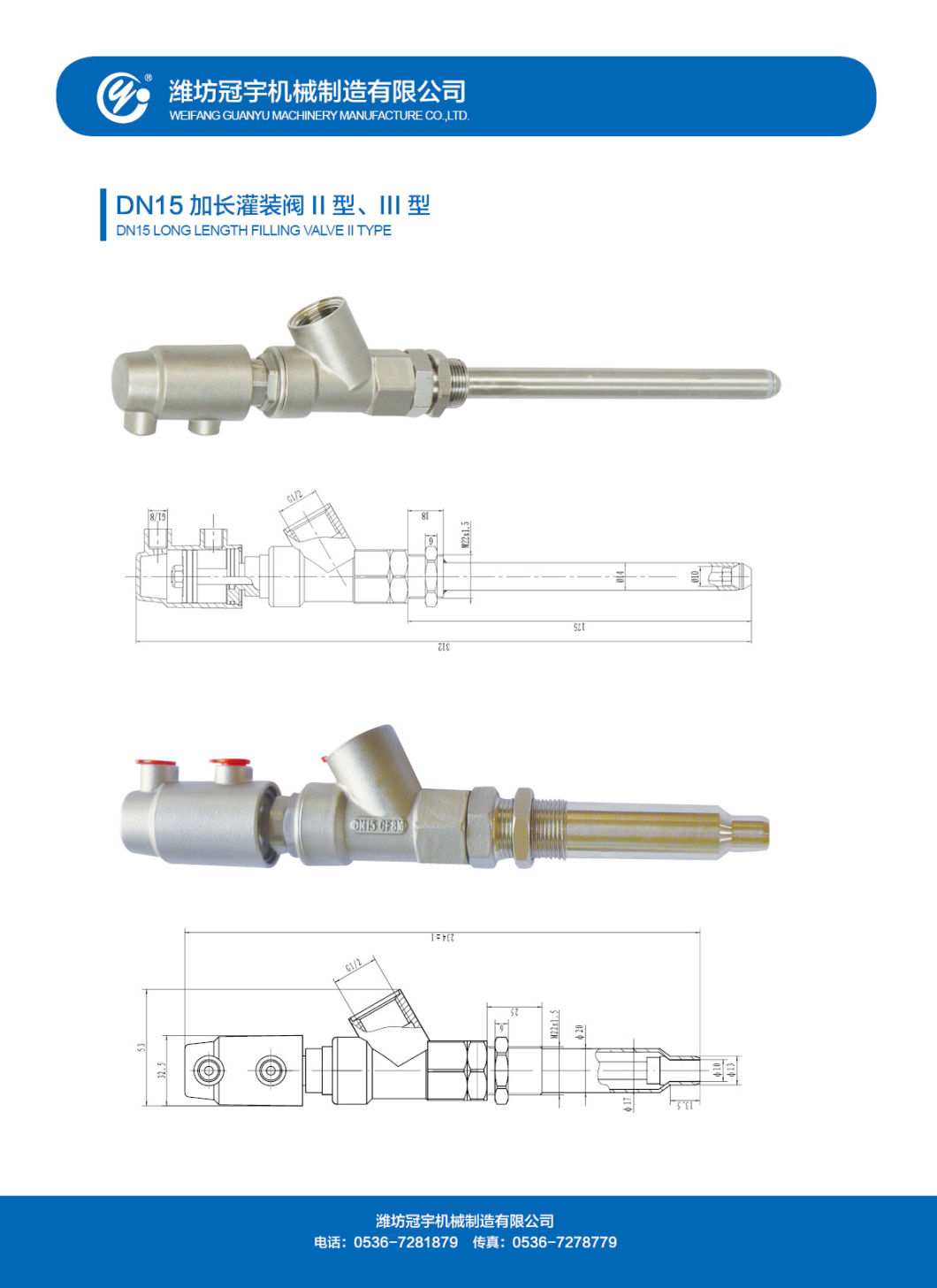Model No.: DN15-DN65 1/2" ~ 2-1/2"
Seal: PTFE
Fluid Temperature Range: -10°C to 120°C
Brand: GUANYU
Packaging: Export Standard
Origin: Weifang, China
HS Code: 8481202000
Filling Valve
Technical Specifications
Double Acting (Without Spring / With Spring)
(Fluid Pressure): 0 - 0.7 MPa
(Control Pressure): 0.35 - 0.4 MPa
(Body Material): CF8 / CF8M
(Seal Material): PTFE
(Operating Temperature Range): -10°C to 120°C


This pneumatic filling valve is designed for use in beverage machines and other industrial filling systems. It comes in a range of sizes from DN15 to DN65, with a nominal size range of 1/2" to 2-1/2". The valve features a PTFE seal, ensuring excellent chemical resistance and durability under various operating conditions. It can operate within a temperature range of -10°C to 120°C, making it suitable for both cold and hot fluid applications. The valve is available in two configurations: double-acting without a spring or with a spring, offering flexibility depending on the system requirements. It operates using fluid pressure ranging from 0 to 0.7 MPa, with a control pressure range of 0.35 to 0.4 MPa. The body is constructed from high-quality materials such as CF8 and CF8M, which are known for their corrosion resistance and strength. Whether you're looking for standard packaging or customized solutions, this filling valve is an ideal choice for your application. It's manufactured in Weifang, China, and complies with international HS code regulations. The product is well-suited for export and is commonly used in food and beverage industries where precision and reliability are essential.
Induction heat treatment system is an advanced metal material heat treatment process that uses the principle of electromagnetic induction to heat metal materials, changing their microstructure and improving their physical and mechanical properties. This system is widely used in multiple industries such as steel, aviation, automotive, and machinery manufacturing, and plays an irreplaceable role in improving material hardness, wear resistance, toughness, and other aspects.
working principle
The core of induction heat treatment system lies in electromagnetic induction heating. When an alternating current passes through an induction coil, an alternating magnetic field is generated around the coil. Metal workpieces placed near the coil will generate eddy currents, known as induced currents, under the action of this magnetic field. When this current flows inside the workpiece, it generates heat, causing the workpiece to be heated. By controlling the current frequency, power, heating time, and cooling method, it is possible to accurately perform heat treatment on the workpiece, such as surface quenching, tempering, annealing, normalizing, etc.
system composition
A complete induction heat treatment system mainly includes the following parts:
Induction heater: generates an alternating magnetic field to heat the workpiece.
Power supply: Provides electrical support for induction heaters.
Control system: Monitor and adjust various parameters of the heating process to ensure the effectiveness of heat treatment.
Cooling system: used to control the cooling rate of the heated workpiece and complete the heat treatment cycle.
Fixture: Fix the workpiece to the optimal heating position.
Characteristics and advantages
1. Precise control: By precisely adjusting parameters such as current and frequency, precise control of heating depth and temperature can be achieved.
2. Efficient and fast: Induction heating has a fast speed and can heat up to the desired temperature in a very short time, shortening the heat treatment cycle.
3. Energy saving and environmental protection: There is no open flame during the heating process, which saves a lot of energy compared to traditional furnaces, and there are no harmful substance emissions.
4. Local heating: It can heat specific parts of the component to avoid resource waste and deformation caused by overall heating.
Application Cases
Automotive manufacturing: used for surface quenching of components such as gears, connecting rods, crankshafts, etc., to improve their hardness and wear resistance.
Aerospace: Heat treatment of key components such as aircraft landing gear and engine blades to enhance their fatigue resistance.
Mechanical manufacturing: Quenching treatment of cutting tools, molds, etc. to extend their service life.
Oil extraction: Heat treatment of parts such as drill bits and pipeline joints to improve corrosion resistance and mechanical strength.
conclusion
Induction heat treatment systems play an indispensable role in modern industry through their efficient heating capacity and precise control mechanism. With the continuous advancement of technology, induction heat treatment systems are developing towards smarter and more energy-efficient directions, and more application scenarios will be developed in the future.
Induction hardening, heating equipment, quenching equipment,, induction heating
Ningbo Dedao Electronic Technology Co., Ltd , https://www.nbdedao.com
![<?echo $_SERVER['SERVER_NAME'];?>](/template/twentyseventeen/skin/images/header.jpg)